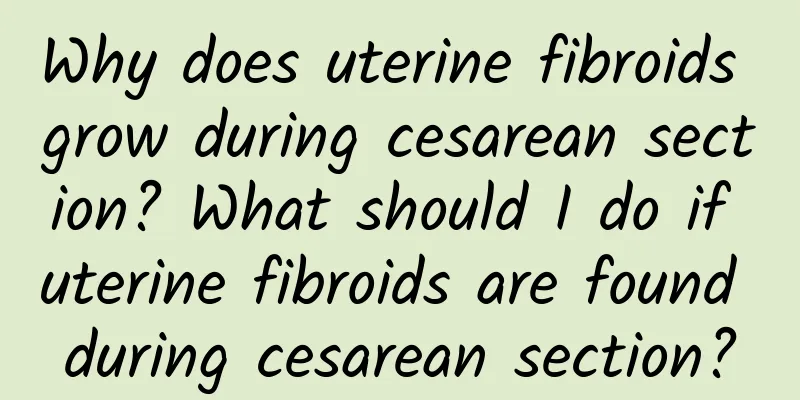Why does uterine fibroids grow during cesarean section? What should I do if uterine fibroids are found during cesarean section?

|
Why does uterine fibroids grow during cesarean section? What should I do if uterine fibroids are found during cesarean section? Cesarean section is a common cesarean section method, often used in cases of difficult labor or fetal development abnormalities. With the popularization of cesarean section, some potential risks and complications have also emerged, including the formation of uterine fibroids. Why does uterine fibroids grow after cesarean section? Caesarean section causes a certain degree of damage to the uterine tissue, such as the incision and suture during the operation, as well as the healing process after the operation. These injuries stimulate the abnormal growth of uterine tissue and may lead to the formation of fibroids. During the recovery period after a cesarean section, women may receive hormone therapy for a period of time to help the uterus heal. However, hormone therapy may have an effect on uterine tissue and further promote the growth of fibroids. What should I do if uterine fibroids are discovered during cesarean section? During a cesarean section, if doctors discover the presence of fibroids in the uterus, they usually make appropriate decisions based on the specific situation. If the fibroid is small and located away from the surgical instrumentation area, your doctor may decide to keep the fibroid and proceed with the cesarean section. However, if the fibroid is large or located close to the surgical instrumentation area, your doctor may decide to remove the fibroid during the same surgery. There are many ways to remove uterine fibroids, such as laparoscopic surgery, hysteroscopy, or traditional laparotomy. The doctor will choose the appropriate surgical method based on the size and location of the fibroids and the patient's specific situation. Although the discovery of uterine fibroids during cesarean section may increase the difficulty and risk of the operation, timely removal of the fibroids can reduce possible postoperative complications and aid in the patient's recovery. Uterine fibroids are a common gynecological tumor, a benign tumor formed by the growth of smooth muscle cells in the myometrium. It usually occurs in women of childbearing age and in most cases does not cause symptoms or problems. However, in some cases, fibroids may cause infertility, abnormal bleeding, pelvic pain or other gynecological diseases. Therefore, timely diagnosis and treatment of uterine fibroids is very important to protect women's reproductive health. In summary, cesarean section may lead to the formation of uterine fibroids, so it is very important to detect and treat uterine fibroids in time during surgery. The doctor will make appropriate decisions based on the specific situation to ensure the safety and recovery of the patient. |
Recommend
Several common manifestations of vulvar itching
More and more people are suffering from vulvar pr...
A brief discussion on the diagnosis of cervicitis
Cervicitis is a common gynecological disease, whi...
What are the main symptoms of pelvic inflammatory disease?
What are the main symptoms of pelvic inflammatory...
Will eating white rice make you fat? Misunderstood! Not the root cause of obesity
(Text by Professor Wu Jiacheng of Chemistry) In t...
Do you know if ectopic pregnancy can lead to death?
It is well known that the occurrence of ectopic p...
Women should pay attention to preventing acute adnexitis during menstruation
Acute adnexitis is usually characterized by lower...
Why do women have irregular menstruation? What are the causes of irregular menstruation?
Irregular menstruation is a phenomenon that many ...
The timing of pregnancy after uterine fibroid removal
Women with uterine fibroids do not need to be too...
What are the consequences of early pregnancy uterine fluid accumulation
The uterus is a product of cervical inflammatory ...
Brief analysis of the two main causes of irregular menstruation
It is understood that many female friends will be...
Are the elderly obese and unable to walk? 3 secrets to lose weight easily and regain your motivation
To live, you have to move. Elderly people are oft...
Principles of dietary supplementation after artificial abortion
Artificial abortion itself is very harmful to the...
What are the diagnostic criteria for uterine fibroids?
Gynecologists say that the diagnosis of uterine f...
Can B-ultrasound detect threatened abortion?
Nowadays, women are under great pressure from bot...
Potatoes are high GI foods, are they not good for weight loss? Study: Controlling total calories is key
The roasted potatoes smell delicious, but people ...









